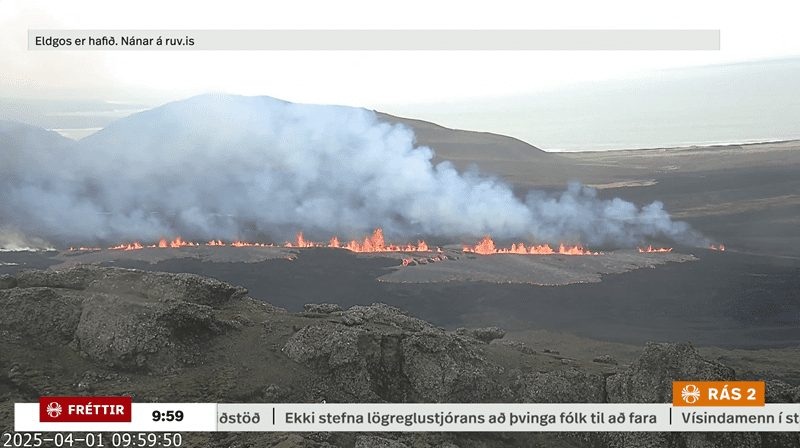A volcanic eruption started on Tuesday, April 1, near Grindavík on the Reykjanes Peninsula. The town had previously been evacuated, and people were not in danger.
Key Takeaways:
- There is a volcanic eruption near the town of Grindavík on the Reykjanes Peninsula.
- Civil Protection and emergency responders have activated their safety procedures and experts from the Icelandic Meteorological Office and the academic community assess the situation and update on the situation regularly. The situation is being assessed and further accessibility information about the area, the eruption area, extent and location, will be updated when it is available.
- Flights to and from Iceland are operating on schedule, and disruption to flight traffic is considered highly unlikely.
 The eruption started around 10am on 1 Apri. It is 11th eruption on Reykjanes Peninsula since 2021.
The eruption started around 10am on 1 Apri. It is 11th eruption on Reykjanes Peninsula since 2021.
This is the 11th eruption in Reykjanes since the first eruption began in Fagradalsfjall in March 2021 and the eighth in the Sundhnúksgígar series.
Civil Protection and emergency responders have activated their safety procedures and experts from the Icelandic Meteorological Office and the academic community assess the situation and update on the situation regularly. The situation is being assessed and further accessibility information about the area, the eruption area, extent and location, will be updated when it is available.
While the possibility of air traffic disturbance cannot be entirely ruled out, scientists consider it an improbable scenario. Typically, the impact of volcanic eruptions is confined to a specific, localized area near the eruption. Notably, previous eruptions in the area did not impact flights to and from the country.
The Icelandic Met Office, in collaboration with the Department of Civil Protection and Emergency Management and a team of scientists from the University of Iceland, is actively monitoring the situation and thoroughly analyzing any unfolding developments.
The Icelandic Meteorological Office, The National Police Commissioner, The Department of Civil Protection and Emergency Management, and a team of scientists from the University of Iceland have closely monitored this situation since the beginning and are constantly analyzing developments based on the best scientific data available.
Iceland is situated on the Mid-Atlantic Ridge, where the North American and Eurasian tectonic plates diverge, making it one of the most active volcanic regions in the world. Regular seismic events, ranging from minor tremors to significant earthquakes, are a characteristic feature of Iceland’s geology. Seismic activity in Iceland is often due to magma movement beneath the earth’s crust. It may sometimes result in magma seeking the easiest path to the surface and becoming a volcanic eruption.
Iceland is no stranger to volcanic activity. Four eruptions have occurred on the Reykjanes Peninsula in the last three years. Icelandic authorities and the public are highly prepared for such events, and Iceland has one of the world’s most effective volcanic preparedness measures. Iceland’s geoscientists possess vast experience in dealing with volcanic activities.
Visiting the eruption site
Although it is a spectacular vision it is important to take all necessary precautions. Visitors are asked to stay away from the Grindavik area and not to stop the vehicles on the Reykjanesbraut highway (no. 41), while the situation is being processed. As for now all roads around the area have been closed. You can find map with locations of good and safe viewing spots on visitreykjanes.is
- The eruption site is closed and therefore hiking in the area is prohibited. Please respect the closures and follow the instructions of the authorities.
- The eruption is best viewed online with a live feed on the media sites mbl.is and ruv.is or from viewing sites from the towns of Reykjanesbær and Vogar.
- The eruption is close to the town of Grindavik and other structures.
- The highway Reykjanesbraut (no. 41) is open and operating as usual and the international airport in Keflavík is functioning normally. All flights are currently operating on schedule. The impact of volcanic eruptions tends to be limited to specific, localized areas near the eruption site. Notably, previous eruptions in the area did not impact air travel to and from the country.
The Icelandic MET office: Information on the seismic activity and development of events
The Icelandic Road Administration: Information on road conditions and closures in the Reykjanes region
Safetravel: Updates on safety
The Icelandic National Broadcasting Service: News coverage
Visit Reykjanes: More updates from the area
Back